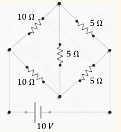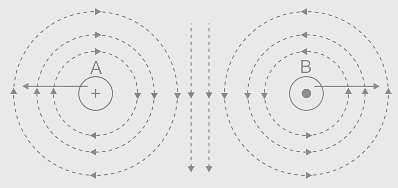A 100-W bulb and 4 25-W bulbs are made for the same voltage. They have filaments of the same length and material. The ratio of the diameter of the 100-W bulb to that of the 25-W bulb is:
4:1
√2:1
2:1
1:√2
The Correct Option is C
Solution and Explanation
The power consumed by a bulb is related to its resistance and voltage. Since both the 100-W and 25-W bulbs are made for the same voltage, their resistances must be different. Let's denote the resistance of the 100-W bulb as \( R_{100} \) and the resistance of the 25-W bulb as \( R_{25} \).
The power consumed by a bulb can be written as:
\[ P = \frac{V^2}{R} \]
where \( P \) is the power, \( V \) is the voltage, and \( R \) is the resistance.
Since the filaments of the bulbs are made of the same material and have the same length, the resistance is directly proportional to the length of the filament and inversely proportional to the cross-sectional area of the filament. Let's denote the diameter of the 25-W bulb as \( d_{25} \) and the diameter of the 100-W bulb as \( d_{100} \).
The cross-sectional area of the filament is proportional to the square of its diameter. Therefore, we can write:
\[ R_{100} = k \cdot \frac{l}{(d_{100})^2} \]
\[ R_{25} = k \cdot \frac{l}{(d_{25})^2} \]
where \( k \) is a constant and \( l \) is the length of the filament.
Since the bulbs are made for the same voltage, we can write:
\[ \frac{V^2}{R_{100}} = \frac{V^2}{R_{25}} \]
Substituting the expressions for \( R_{100} \) and \( R_{25} \) and simplifying, we get:
\[ \frac{(d_{100})^2}{(d_{25})^2} = \frac{100}{25} \]
\[ \frac{d_{100}}{d_{25}} = \sqrt{\frac{100}{25}} = \sqrt{4} = 2 \]
So, the ratio of the diameter of the 100-W bulb to that of the 25-W bulb is 2:1.
The correct answer is option (C) : 2:1
Top Questions on Current electricity
The voltage across a 5Ω resistor is given as V = 200 sin(100πt). Find out the time required for current through io it to change from\(\frac{i_0}{2}\) to i0 [ i0 is peak current]
- JEE Main - 2024
- Physics
- Current electricity
- In the given circuit, find electric current drawn from battery :

- JEE Main - 2024
- Physics
- Current electricity
- An infinitely long wire, located on the z-axis, carries a current I along the +z-direction and produces the magnetic field \(\bar{B}\) . The magnitude of the line integral \(∫ \overrightarrow{B}.\overrightarrow{dl}\) along a straight line from the point \( (−√3a, a, 0) \)to \((a, a, 0)\) is given by [\(\mu_0\) is the magnetic permeability of free space.]
- JEE Advanced - 2024
- Physics
- Current electricity
- Which of the following is not a measuring function of a multimeter?
- AP POLYCET - 2024
- Physics
- Current electricity
- Two infinite current carrying wires having current I in opposite directions are shown below.

Find the magnetic field in S.I units, at point- JEE Main - 2024
- Physics
- Current electricity
Questions Asked in BCECE exam
- Instantaneous displacement current of 1.0A in the space between the parallel plates of 1μF capacitor can be established by changing the potential difference of:
- BCECE - 2023
- Electromagnetic waves
- What is the r.m.s value of an alternating current which when passed through a resistor produces heat, which is four times that produced by a current of 2A in the same resistor?
- BCECE - 2023
- Alternating current
- In the displacement method of \(l_1\) and \(l_1\) be the sizes of two images, then the size of the object is:
- BCECE - 2023
- Ray optics and optical instruments
- A beaker is a field with water (μ=\(\frac{4}{3}\)) up to a height of 33.25cm. A concave mirror is placed 15 cm above the water level and the image of an object placed at the bottom is formed 25cm below the water level. The focal length of the mirror is nearly :
- BCECE - 2023
- Ray optics and optical instruments
- An air doubble is inside water (μ=\(\frac{4}{3}\)). At what distance from the air bubble should a point object be placed so as to form a real image at the same distance from the dubble? (r is the radius of curvature of the bubble)
- BCECE - 2023
- Ray optics and optical instruments
Concepts Used:
Refraction of Light
Refraction is the bending of a wave when it enters a medium where its speed is different. The refraction of light when it passes from a fast medium to a slow medium bends the light ray toward the normal boundary between the two media. The amount of bending depends on the indices of refraction of the two media and is described quantitatively by Snell's Law.
If you ever observe a pencil dipped into water, you’ll notice that it seems to be tilted at an angle at the interface of air and water, or the bottom of a tub or a tank that contains water seems to be raised. This phenomenon is caused due to the process of refraction of light. Refraction of light is the bending of the light wave, passing from one medium to another, which is caused due to the difference in the density of the two mediums.
Reason behind Refraction
The main cause of refraction is the variation in the velocity of the light when it enters different mediums. The speed of light in the air is faster than that of water. So, the speed of the light increases when it travels from water to air, and similarly, the speed decreases when it travels from air to water.
In the below figure, it is shown why the printed alphabets appear to have risen when seen through a glass slab. This is because when the light travels from air to glass, the speed gets reduced and the light moves toward the normal, that is the light rays move towards the NN’ normal from its original path. Likewise, when the light ray travels from glass to air, its speed gets increased and it moves away from the normal.
Refraction of Light in Reality
- Twinkling of the stars - The atmosphere is composed of areas of the thick and thin atmosphere. When one looks at the stars at night, the light passing through these different layers of the atmosphere from the stars reaches our eyes and therefore the stars appear to twinkle.
- As the light travels from the bottom to the top, the light coming from the pool bends due to refraction and thus the swimming pool always looks shallower than it really is.
- Due to the refraction of light, white light when passed through a prism splits into red, orange, yellow, green, blue and violet colours.
Laws of Refraction of Light
There are two Laws of Refraction. They are:
- The incident ray, the normal to the interface of two media, and the refracted ray, all lie on the same plane.
- Snell's Law: Snell’s law states that the ratio of the sine of the incident angle to the sin of refracted is constant. It describes the relationship between angles of refraction and angles of incidence.



